EBR charges a service fee to manufacturers to produce ebike reviews and videos, this began in 2018. It’s the same flat fee for each bike, and it helps us to keep the site going while limiting ad clutter. We appreciate the opportunity to serve you with our opinions and data but respect your right to know that we receive compensation :)
The Haibike Urban Plus has been on my radar since it was introduced in late 2016, because it is completely unique in the product line. It uses a custom designed TranzX battery and compact circular TranzX mid-motor while almost all of the other Haibike models to date (that I’m aware of) utilize either Bosch or Yamaha drive systems. TranzX is a less expensive, less responsive alternative that is commonly found on Raleigh and IZIP e-bike models (two brands owned by the Accell Group, parent company of Haibike since 2002). That said, the M25 is one of the most premium TranzX offerings and performed surprisingly well during my test rides, even offering some shift detection to protect the 10-speed Shimano Deore XT drivetrain. Nice! This is an ebike that did not look comfortable to me, but actually rode pretty well because of the nearly plus-sized 2.4″ wide Schwalbe Super Moto-X tires (official plus sizes are 2.6″, 2.8″, and 3.0″ width). By lowering the tire pressure just a touch (anywhere between 30 and 55 PSI), sticking to smooth paved roads, and possibly adding a 31.6 mm suspension seat post, you can have a blast going up to 28 mph while staying clean and relatively safe thanks to plastic fenders and nice integrated lights. Weighing in at just under 60 lbs, the Urban Plus is not an especially lightweight electric bicycle, but it is well balanced, and comfortably solid. The additional weight pairs well with the bigger tires to absorb vibration and bumps. Thes 27.5″ wheel diameter offers a lower attack angle than 26″ found on many Stromer models (a strong competitor) which helps it span cracks and small imperfections in the tarmac. It’s not as quiet or simple as a Stromer, but the middrive offers efficiency as you shift gears. And so, the bigger tires, upgraded rims, and strong thru-axles (front and rear), add to the rear rack, full alloy chain guide, and higher capacity battery pack to make this a heavier bicycle, but it also makes it durable and performant. I came into this review thinking the bike was a bit off and possibly cheap because it’s different from the rest of the Haibike pack. I think a lot of people in the industry have felt this way and been uncertain about the complex COBI system (now owned by Bosch) and have portrayed these uncertain feelings to their customers. As a result, we have seen it go on sale and become a very compelling offering. What I discovered during the ride test and deep dive, while gathering stats and preparing for the written portion here, is that the motor is actually pretty impressive but still quiet and the COBI phone-app display system can either be amazing and fun or annoying and distracting, especially in bright light because of glare or complete darkness because of how large and bright a phone display can be. It all depends on your willingness to learn about the software and deal with something a bit new. The great thing is, you can operate the bike without using the phone app if you want. In any case, you get to interface with a vast network of Haibike dealers who can offer test rides on one of the three frame sizes and two colors on offer, and who will be able to support the two-year comprehensive warranty. There’s a lot more to say about this ebike, and I’ve done my best to be efficient with the writeup that follows, I also tried to be efficient with the 30+ minute video review above, but there was just a lot to cover ;)
Driving this bike is a very compact, circular, mid-drive motor from TranzX. The M25GTS is a high-sped motor, capable of assisting riders up to ~28 mph, making the Urban Plus a Class 3 speed pedelect. You get 500 to 550 watts of output, and up to 70 Newton meters of torque, positioning this near the Yamaha PWseries SE and Bosch Performance Line Speed products. Weighing in at ~8.6 lbs, it’s not as light as it is small, but it is quiet. I was really impressed by how little noise it produced during my test rides. I could hardly hear it at all when my friend Virginia took it out and I ran next to her for a short bit. My experience was that the motor did not switch on as hard and fast as Bosch and Yamaha, and had a bit of wind-down time when I stopped, but it was a lot more dynamic than some of the basic TranzX products that only measure pedal cadence. This thing measures pedal cadence, pedal torque, and rear wheel speed… and, it measures shifting. Not perfectly, but it’s still a welcome and somewhat rare feature. If you’re pushing hard and the motor is assisting you with high power, there’s a potential for “mashing” which is where the chain grinds across the sprockets and pulls hard on the derailleur. It makes a chunking sound and will damage the drivetrain over time. It’s one of the drawbacks to having a mid-motor (because you need to shift in order to empower the motor, but this in turn can damage the hardware). I found that the system worked best when I would ease back on my pedal force just a touch and then shift. If I was pushing hard, I could still induce mashing and would hear the shift detection kick in slightly after the gear had already been changed. In short, I like how small and quiet the TranzX M25 is. I love how small the casing is, and how nicely it blends into the frame here (staying completely hidden the 48 tooth chainring). I think the shift detection, while imperfect, is much better than nothing, and really beneficial on a wider range 10-sprocket drivetrain like this. I feel like I’ve been won over a little bit, and don’t feel so uncomfortable with the brand at this point… especially with the lowered price point and warranty.
Powering the motor, the COBI Hub (plastic smartphone mount), both lights, and the electronic bell and siren alarm system, is a 48 volt 10.2 amp hour Lithium-ion battery pack. It offers nearly 500 watt hours of capacity, which is a bit above average, but definitely what you’d want for a speed pedelec. The faster you ride over ~20 mph, the more air resistance you’ll encounter and the harder the motor will have to work, thus draining the battery more quickly. I really like how cleanly the pack seats into the downtube, it’s almost smooth and really blends in nicely. I appreciate how simple and bright the LED power indicator is, on top of the pack, and how the charging port on the left side is clear of the left crank arm and pedal. The included two amp charger does an average job of filling the pack and isn’t especially large or heavy, but I like the metal end piece they used because it won’t crack as easily as the small plastic ones that many other brands use. There’s a key slot on the top right side of the downtube, used to unlock the battery. This cylinder did not appear to be spring loaded, so you’ll need to make sure you’ve turned the key back before pulling out. It’s a minor gripe… I do like the inset key design and just the fact that you can charge this battery on or off the bike frame. For people who live upstairs and do not want to carry the 59 lb frame, just take the battery pack, your phone, and the COBI hub off for the night and leave the bike outside. For people who may encounter extreme heat and cold, it’s best to store the pack in a cool, dry location to maximize life. I’ve heard that the sweet spot for making Lithium-ion cells last is 20% to 80% full, so check in on it every month or two if you haven’t been out for a ride. Just be careful not to drop the battery, because it doesn’t have a handle or loop built in. Weighing just ~5.6 lbs, it’s not especially heavy, just a bit less secure to hold than the standard Bosch and Yamaha external packs on many other Haibike models. Dropping this thing would be an $800 mistake ;)
Operating the Urban Plus can be quick and easy, or somewhat complex and awesome! Once the battery pack has been charged and clicked into place (seriously, push down and listen for the click before riding), you press a little black button on the right side of the COBI mount to turn it on. From here, you can click the up and down keys on the remote button pad, which is positioned near the left grip. Arrow up through the four levels of assist and listen for a double chime when you reach the top. That’s it… no other LCD console or readouts to show your speed or range, just the basic LED readout on the battery pack itself to approximate battery charge level. That’s the simple version without the phone app… For people who have an iOS or Android smartphone, look for the COBI.bike application which matches the branding and may be linked from the official COBI.bike website here. The people that made this system come from the automotive industry and wanted to bring the music, phone, navigation, and security features you’d expect from a premium automobile. You can see this in the headlight design, which has three running modes (daytime, bright, and auto) and curved LED outlines. Once you’ve got the app installed, you can connect it to the bike using Bluetooth and then seat it in the spring loaded mount and plug it in with Micro-USB or Lightening (or use an official COBI phone case to reduce wire clutter). With the app launched and connected, the bike will take you through a setup flow and get some information about what color scheme you like and what you’d like to name the bike. It eventually shows your current speed, chosen level of assist, battery capacity, and a bunch of optional sub-applications like music, telephone, and GPS. The navigation setup is pretty cool, using vectorized images to save on data downloads and improve load times. You can select from the fastest, shortest, or quietest route to your planned destination and even get feedback on how the weather is set to change over the course of your ride. Pretty sweet… and most of this can be controlled via touch screen on your phone or more safely with the rubberized arrow button pad thing near the left grip. It did take some time to update the firmware in the COBI hub and in the smartphone app before we could ride, so plan for an additional hour of setup time here. The good news is, the app will get smarter and more feature rich with time as new software versions are introduced. To disconnect your phone from the bike (if you’re selling it or maybe just demoing the bike), go into the COBI app, press the gear icon for settings, scroll down to My Bike, then choose Reset and Release Hub.
Depending on your access to a shop, the price being charged, and your willingness to try something a little different, the Haibike Urban Plus could be an excellent choice. I spent time covering this bike at the Electric Bicycle Shop of Santa Barbara and was accompanied by the owner of Amego Bikes in Toronto who both had good things to say about the product. Virginia in particular, was excited about how city dwellers had been using it to zip around town for work or to make food deliveries. The hardware is definitely a step up with sealed cartridge bearings, nicer pedals, the fancy lighting system (I love how the backlight goes bright when you pull the brakes). You can go fast, use power efficiently, and stop on a dime with the hydraulic disc brakes – especially with the larger 203 mm front rotor. Some of the hardware is even specced for European standards (the larger brake levers for example), and I love that they put the kickstand way back so it stays clear of the left crank arm if you are backing the bike up or maneuvering it in a tight space. The handlebars aren’t super wide, so it fits between cars and through doors easily. Apparently, the dongle adapter thing that comes with the charger and setup guide will let you adjust the controller amperage to raise or lower the current by 3% to optimize for quick starts or slower more efficient starts… and that’s pretty rare and unique. The one thing that seems to be missing is set of bottle cage bosses. Alas! perhaps they didn’t want to compromise the frame integrity or just thought the rear rack was enough. Consider the SKS Anywhere adapter if you want to fit a folding lock or other tool onto the seat tube (which seems especially wide here). Big thanks to the shops for partnering with me on this review and to Haibike for making beautiful bikes. I welcome your feedback in the comments below or the Haibike Forums and I’ll do my best to help answer questions.
Pros:
- This is the only Haibike that I have seen to date which uses the TranzX M25 mid-motor, this motor tends to cost less and be physically smaller than Bosch and Yamaha, it basically disappears on the frame behind the 48 tooth chainring
- The battery pack also blends into the frame nicely and only weighs ~5.6 lbs, which is great for a ~500 watt hour ebike battery (most weigh 5.8 lbs to 7 lbs)
- The frame feels stiff (no frame flex), the fenders are attached securely and aren’t as prone to damage as aluminum or steel because they are made from flexible plastic, it’s just nice to have most of the weight low and center vs. on a rack battery or in a big hub motor in the rear wheel
- As a Class 3 speed pedelec (capable of reaching ~28 mph with pedal assist) the bike is sporty, fast, and great for commuting or delivery applications, but less efficient because of wind resistance above 20 mph, the good news is that the mid-drive motor is more efficient than most hub motors because it leverages the nice 10-speed drivetrain… so to me, this is one of the more efficient Class 3 products
- Mid-motors are efficient, but can increase the strain and wear of your chain, cassette, and derailleur, so it’s very impressive to see shift detection in use here! This makes the motor ease off whenever you shift gears, reducing wear on the drivetrain
- You shouldn’t experience many chain drops with this e-bike because the chainring has a sturdy guide; two alloy plates sandwiching the chainring to keep things on track, these plates double as a bash guard to protect the chainring teeth, motor casing, and your pant legs when pedaling
- Haibike did an excellent job with safety here, you get premium Schwalbe Super Moto-X tires with puncture resistance and reflective stripes, you get bright front and rear lights (with three modes for the headlight), and you can choose the white frame if you really want to stand out and increase your visual footprint (though the grey frame helps hide the battery and wires a bit better and might hide dirt and scratches too)
- Both lights are active whenever the bike is turned on but the headlight has a sensor that goes brighter vs. the basic running light stripes along the sides (which look awesome), I love how the tail light goes bright when you pull the brake levers, it really keeps you visible and safe when riding in traffic
- Great utility on offer, the wide fenders should keep you dry, the rear rack is capable of supporting up to 55 lbs and provides secure attachment points for the rear fender, and the rack is positioned far back enough to stay clear if you drop the saddle all the way down
- Fantastic hydraulic disc brakes here, the larger 203 mm front rotor allows for faster cooling and more power when braking with these taller wheels and heavier tires, the rear 180 mm rotor is great too vs. a 160 mm on some other products
- The price is amazing for such high quality hardware and such a cool looking frame in two colors and three frame sizes! most competing products are at least $2,500 and can range beyond $5k for Stromer in particular
- I really appreciate that you don’t have to use your phone with the COBI interface to ride this bike, sometimes it’s faster and simpler just to turn it on and use the button pad to adjust assist and go…
- It’s neat to see how much information the COBI system can give you through their smartphone app, you can take phone calls, get GPS directions, even choose routes that are fast vs. quiet and get an idea of weather along your planned route, I love that there’s a Micro-USB port for charging your phone as you use the app and ride
- In addition to bluetooth, the COBI system supports ANT+ which could be used with a heart rate monitor, the display also shows your pedal stroke power and RPM to get deeper insights on what kind of exercise is happening and sync with Apple Health
- The battery is really small, perhaps you could get a spare to stick in a bag, the charger is also pretty lightweight and has a tough metal end so it should hold up better over time if jostled around or dropped
- Great hardware upgrades, the rims use reinforcement eyelets and both wheels have thru-axles, the kickstand is positioned clear of the left crank arm and is adjustable, the sturdy alloy pedals from VP
Cons:
- The bike felt pretty good to me because it uses higher volume 27.5″ x 2.4″ tires and ergonomic grips, but the fork is rigid aluminum (not as comfortable as steel, carbon fiber, or a suspension fork), at high speeds the bike can cause some back, neck, arm, and wrist fatigue on bumpy roads, consider a 31.6 mm seatpost suspension
- Plastic fenders tend to rattle more, these ones seemed very secure (and are made by SKS, which is a leader in the space) but they may not be as silent as tubular alloy fenders and could get warped (the front fender was a little off to the side on our demo bike in the video and images above)
- It’s great that the bike uses a sturdy 15 mm thru-axle for the front wheel because it adds strength and rigidity compared to a 9 mm skewer, but the quick release mechanism makes it vulnerable… so always lock the front wheel along with the frame, there are fewer options for 15 mm security hardware like Pinheads on the market right now
- The COBI app takes a bit of time and patience to setup, we had to charge the bike and let the COBI mount fill up before it could download a software update and then sync with our phone before doing another software update, expect 1+ hours of time just screwing around before you can use the phone
- No bottle cage bosses on the seat tube (or anywhere) which is too bad, you’ve got the rear rack to work with and could mount a trunk bag or panniers there, but it’s nice to use bosses for folding locks and other accessories when you don’t want to bring a bag and it really seems like there was room on the frame, you might be able to use an SKS Anywhere adapter set like this with the fatter seat tube but I’m not 100% sure
- I was surprised that the Shimano Deore XT derailleur on this bike does not have the one-way clutch to tighten the derailleur spring and reduce chain bounce and slap, it’s a feature I see on this same component group level for a lot of other speed pedelec electric bicycles
- Minor consideration here, just be careful with the battery pack (mounting and dismounting to store or charge off-bike) because there’s no handle or loop to give you a secure hold, at least the bike is stable with the kickstand so getting the pack off shouldn’t be too tricky like some mountain models, I noticed that the locking cylinder for the battery is not spring loaded so you do have to spend a bit more time and effort locking the pack back onto the bike
- The COBI control pad has a white LED that can be a little bright and distracting, along with your smartphone shining up into your face… I rode in the dark and was trying to figure out how to dim the lights or go into night mode, please chime in with a comment below if you know how to do this or have feedback
- Even though there’s a cool siren alarm (that must sense wheel movement, because it’s extremely sensitive) there isn’t any sort of phone notification to let the owner know about tampering, it’s just a simple audible alarm to alert passers by who might see the thief
- The front plastic fender was a bit twisted and this could have been because of how the wires were routed… or just how it was shipped, I have found that positioning it correctly with some cardboard or styrofoam underneath and using a hair dryer or other gentle heat source (even just the sun) can help to straighten plastic back out, just be careful not to leave the battery outside in the hot sun because it’s hard on the cells
Resources:
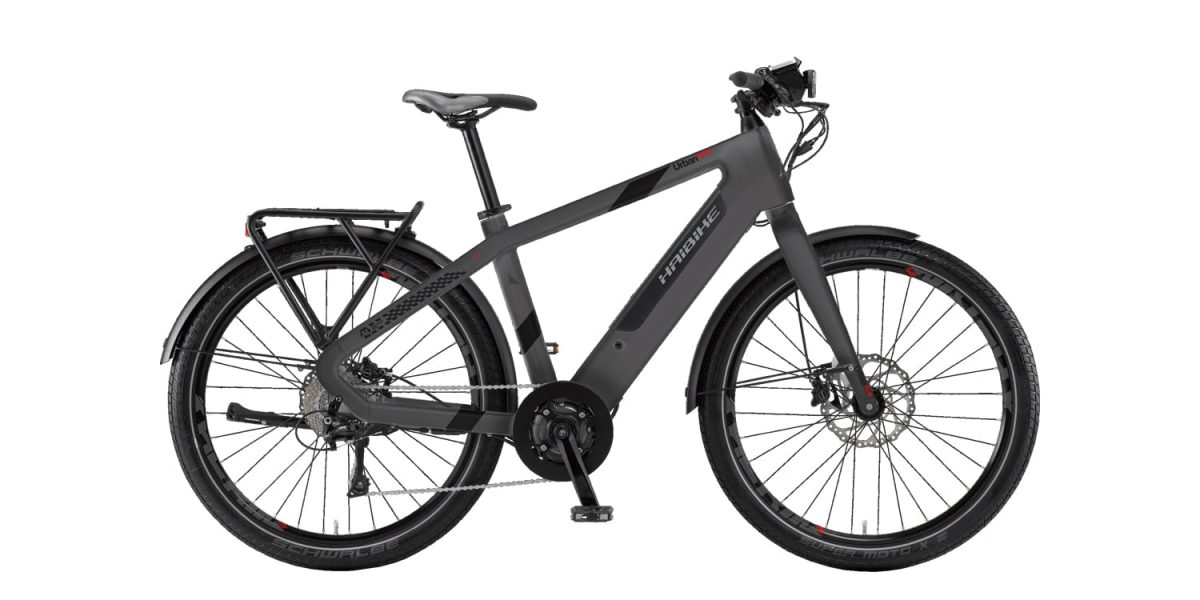















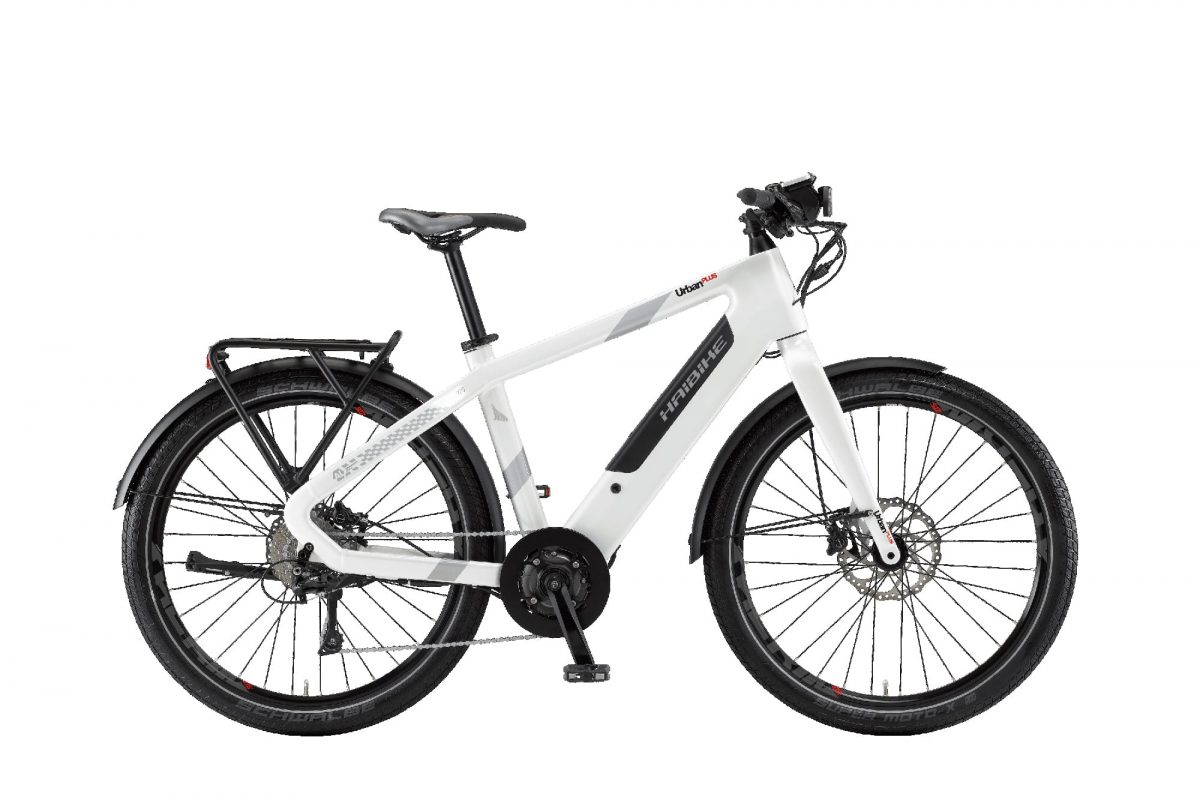
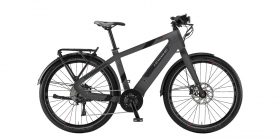
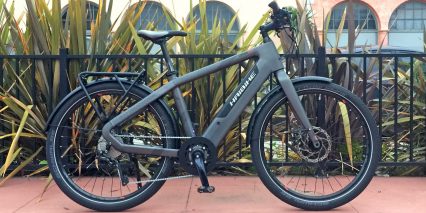
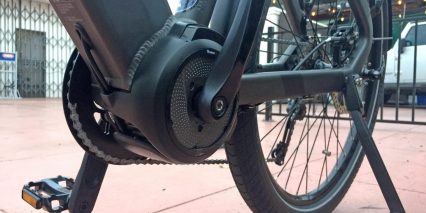
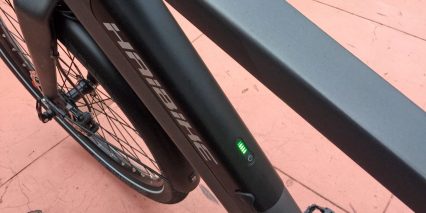
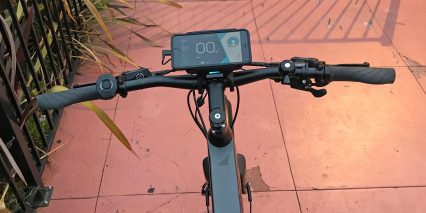
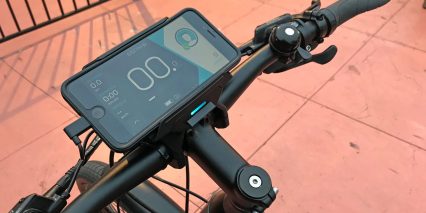
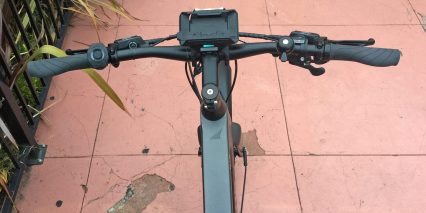
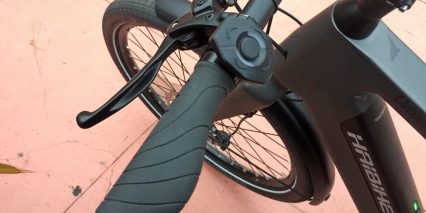
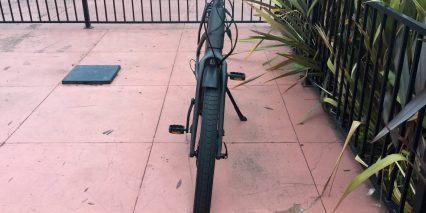
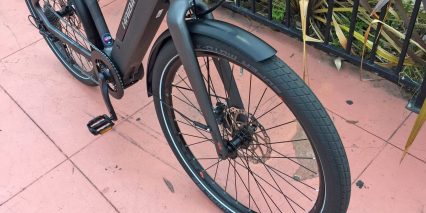
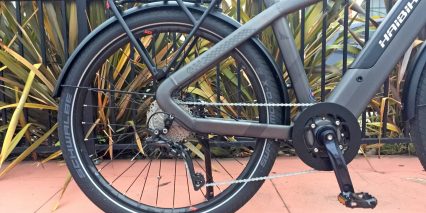
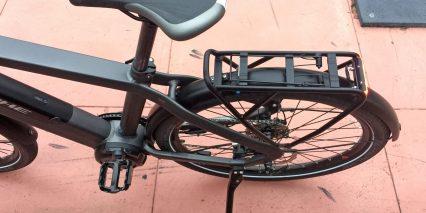
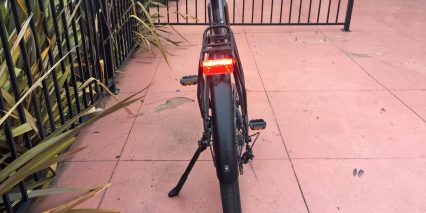
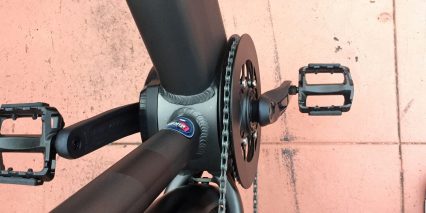
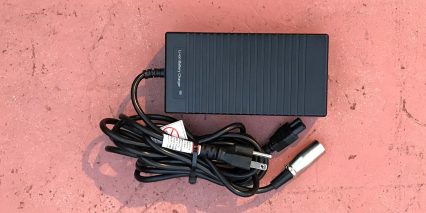
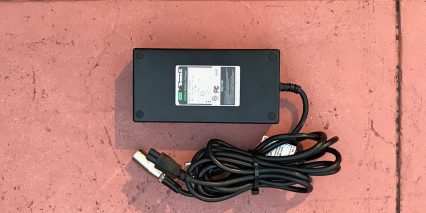
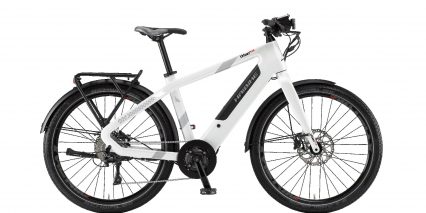

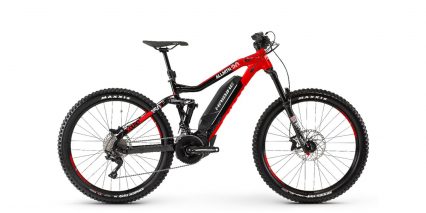
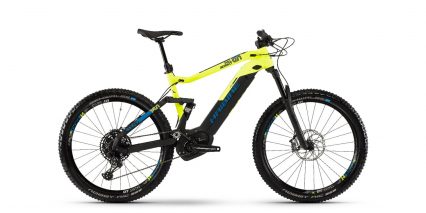
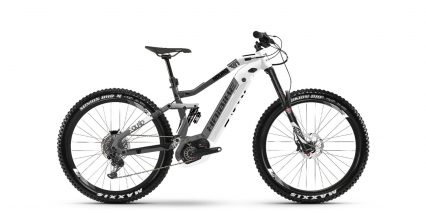

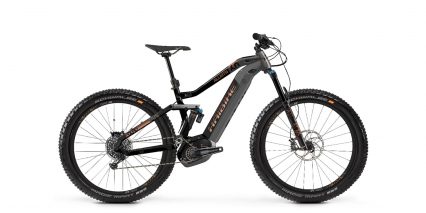
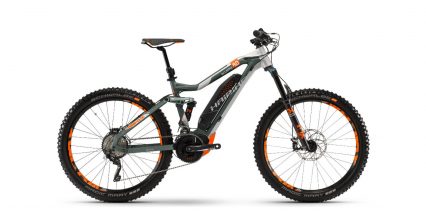
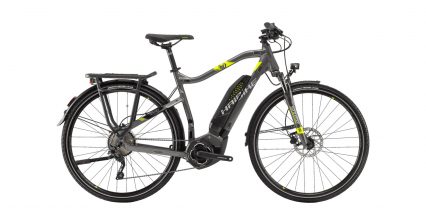
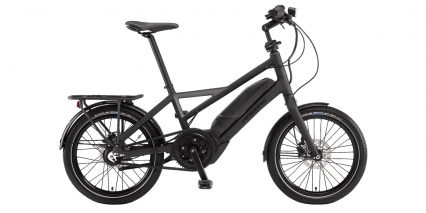
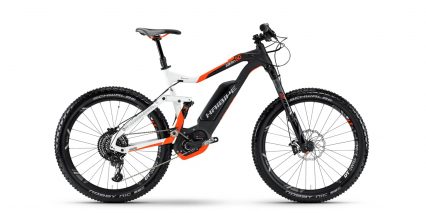
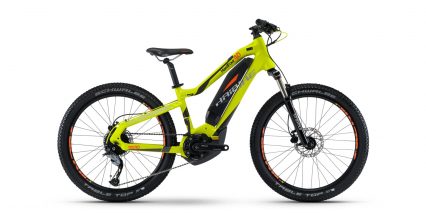
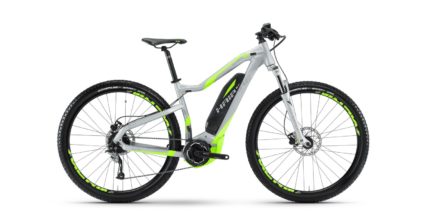
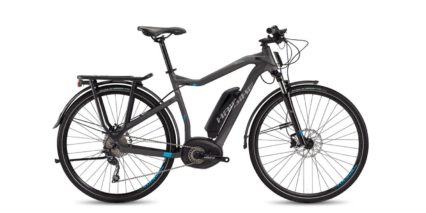
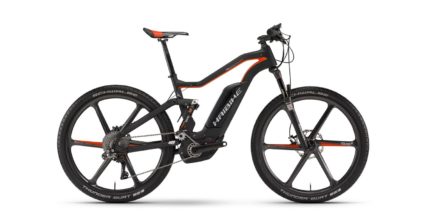

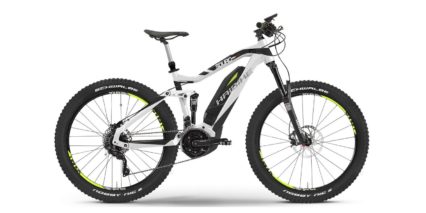
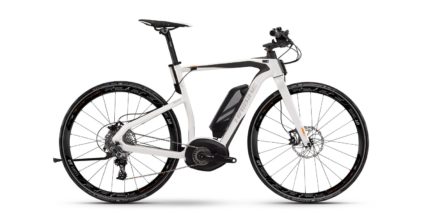
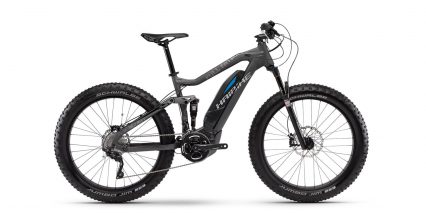
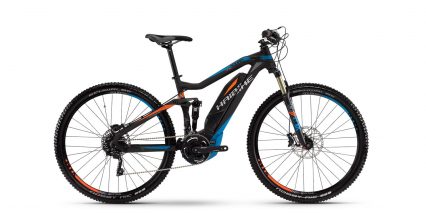
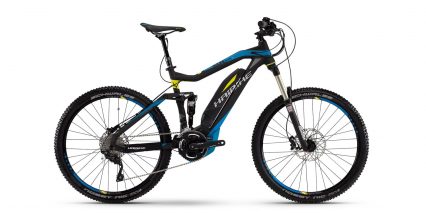
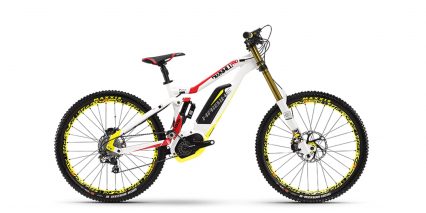
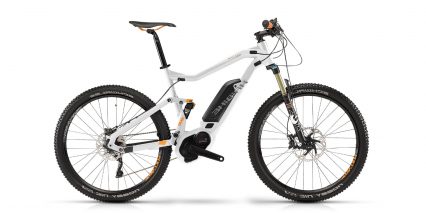
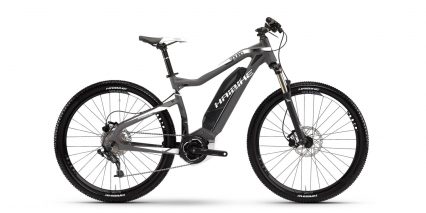
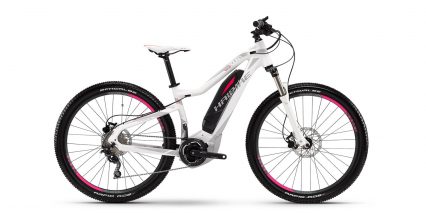
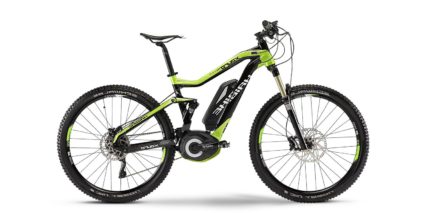
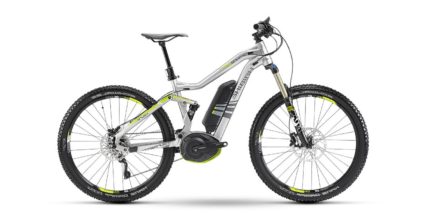

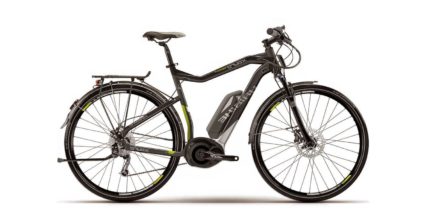

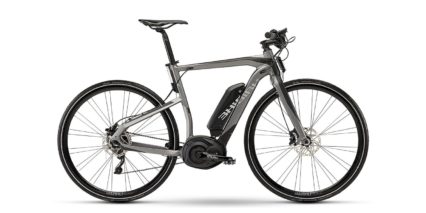
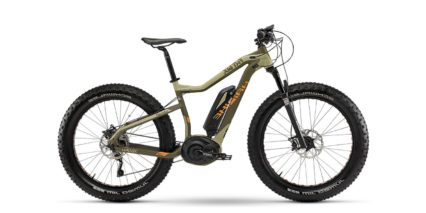
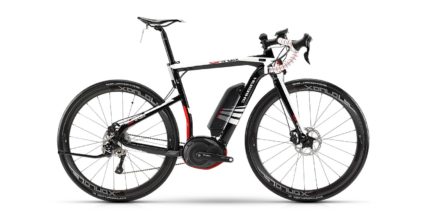
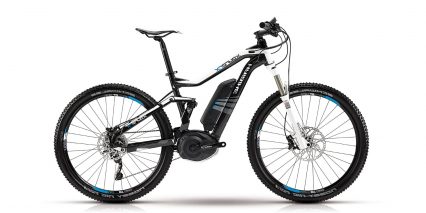
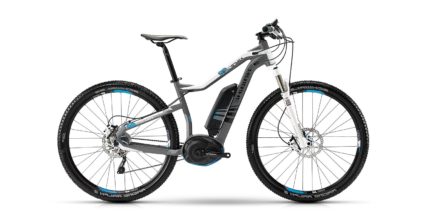
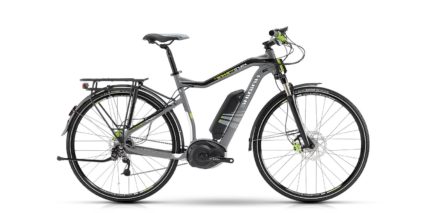
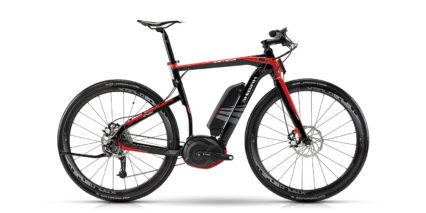
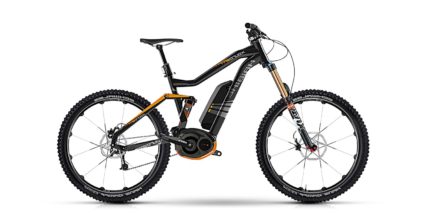
John
7 years agoWOW, the big surprise here is the price and Haibike’s cheating on their German suppliers (mainly Bosch) and going with the value parts supplier TransX. Clearly Haibike is going down scale and the timing/pricing is suspiciously looking like a response to the soon-to-be-released Yamaha bikes (and supplier to Haibike for 2017 drive systems). Its a good idea for Haibike to have a few more affordable bikes to respond to Yamaha and others. I did note the new Yamaha bikes have some significant cost comprises like no dropper on the MTB. Well done to TransX in getting a smallish motor with 2 downtube solutions in the market while engineering powerhouse Bosch struggles getting its downtube solution to market. Look forward to EBR review of new Yamaha models and perhaps suggest a survey of all the drive systems out there, including Chinese suppliers, aside from the usual suspects like Bosch & Yamaha.
Replycourt
7 years agoHey John! It is neat to see the brand adjusting a bit, and doing pretty well with this entry (even though it has always felt a little awkward to me, being branded a Haibike). They are known for high-end electric mountain bikes… but the trekking models are solid, and this one did pretty well for itself during close examination (at least for me). I’m excited to see the new Yamaha tech. What do you mean by “a survey of al drive systems” like a comparison video or article. Are you suggesting that I survey users about their experience with each? Maybe that could be setup in the EBR Forums or something.
ReplyRay Schmidt
7 years agoWell, I just purchased the 2017 Model of this bike in white from Random Bike Parts for $1700.00. Specs seem to be identical. Has a decent waranty and good specs. I think that’s a extremely good price for a Pedelec with the included technology. We’ll see what I feel about it in a couple months.
Replycourt
7 years agoAwesome! Yeah, I’d love to hear how it holds up for you and what your thoughts are after some time riding. Thanks for the quick update and feedback Ray :)
ReplyPeter Julber
7 years agoWould anyone care to help with sizing? I see this available in 3 sizes: 43, 48 and 53. I’m 5′ 11″ and figure the 53 would be my size. Anyone care to comfirm? Very interested in this bike with the current price drops. Thank you!
Replycourt
7 years agoHi Peter, I agree that you’re probably either a 48 cm or 53 cm. There’s not a huge size difference there, so it might come back to your own body position preference. Some people prefer a shorter frame (especially on road bikes) to make them more nimble and lightweight. You can always adjust the saddle by sliding it forward and back a bit. you could swap the stem eventually for something longer or shorter. I guess what I’m saying is that you’re between sizes and could go either way… but I’m not a professionally trained bike fitter. Maybe others will chime in with feedback too :)
ReplyDale
7 years agoCourt, you said you are 5′ 7″ ? How tall is Virginia? I’m thinking the medium (19″) would be a good compromise between myself at 6′ and the wife at 5′ 7″ . Thanks.
Replycourt
7 years agoHi Dale! I’m actually 5’9″ and cannot say exactly how tall Virginia is (maybe 5’3″?) I do agree that a Medium size frame would be a good way to go, to fit both you and your Wife. I’d love to hear how you like the bike!! You can contact Virginia directly, at her shop called Amego EV, and ask her height and recommendations. I hope the size you want is available :D
ReplyJohn Donahue
7 years agoGreetings Court, First off, I want to thank you for doing this thorough review. I am still, essentially new to electric bikes; although own and use about ten ss, city, internal and conventional multi- gear, touring and recumbent 2 wheel and trike manual bikes. Learning of the Urban Plus was a revelation. I’ve had changes to my health, primarily associated with chronic fatigue; and so I’ve been wishfully considering an e-bike, but with my current situation, the idea to get one financially was not really practical or affordable.
Following your review, I became aware of the discount offered for the 2017 Urban Plus; and did indeed was able to obtain a Large frame. So Impressed and Pleased now that I was able to get it. Remarkable Bike. But that being said, having followed comments and discussion with the Haibike forum within EBR; there seems to be contrasting conjecture as to the bikes’s quality, soft/firm-ware issues with COBI and the causes/reasoning behind Haibike’s decision to discount the 2017 model, and/or whether the model will remain for 2018 and/or beyond.
My dealer’s take was that Haibike has now been more completely absorbed into Accell/Raleigh’s corporate structure and orbit; and that they wanted to basically clear the board with unsold stock and maybe discontinue the model. I don’t know. The Urban Plus remains on Haibike’s website under the Trekking category, but no longer appears prominent as to the 2018 offerings. Could you comment and/or really ideally provide an addendum to your review, to basically address these issues noted above? Otherwise, I got to say I really love the inspired design, specs and functional realizations of the Urban Plus; so am completely satisfied with my successful quest to obtain one.
Additionally, I want to say I appreciate your efforts to put thoughtful commentary with your reviews. I understand your reciprocal access to products, vendors and manufacturers; so the need for the consumer to pay attention to do their own homework is incumbent on your audience. Thank you for your work to illustrate in a thoughtful way the variety of ebike options available.
Replycourt
7 years agoHi John! I was actually surprised to see the Urban Plus model available for 2018 and being sold as a 2018 year product. I couldn’t tell what had changed since 2017 and perhaps you are correct that it is just being carried forward superficially to help clear inventory. It seems like there’s always a bit of experimentation from brands that try new ebike systems each year, you can see this with the BULLS Outlaw E45 that tried the SR Suntour hub motor in 2016. I usually try to stay focused on the bikes and current state of things when reviewing vs. introducing conjecture and instead, leave that to the comments and forums. In that sense, I really appreciate your comment and welcome further feedback about how the bike performs for you in the coming months and years. I hope the COBI system works well and that Haibike upholds the good support and customer service that they and the Accell Group are known for :)
ReplyJohn Donahue
7 years agoYes, understandable… Accuracy and Truth are indeed a slippery slope, and debating conjecture is a sticky wicket – Thanks for the reply. Cheers
Anthony Le
7 years agoBecause a coworker bought this bike, I looked into this bike as well, in addition to the Juiced Crosscurrent S bike. I bought this bike for $ 1809 after sales tax. The price, the upgraded components compared to the CC S Juiced bike, the higher efficiency of mid drives, and the FUNCTIONING COBI system, were factors that tipped the balance towards this bike.
I am using this bike as a commuter bike to work, so the absence of a suspension system compared to the Juiced CC S bike did not bother me. What puts this bike down slightly is that for an urban commuter bike with a daily commute of 12.5 miles one way, I was looking for the fastest legal transportation means within the speed pedelec category. After 2 weeks of trying this bike out, my average commute speed ends up being between 19-20 mph taking about 37-40 minutes. On relatively flat and straight terrain going down-hill with a bit of wind in the opposite direction, I easily reach 25 mph, but have to work hard to get up to 26 mph. I am NOT able to reach 28 mph unless I am going down a steep downhill slope and pedal. Were the Haibike Urban Plus able to reach 28 mph more easily, then the average speed might be 2-3 mph higher as well which would cut the commute time down to 31-32 minutes. This is important to note because it appears that the Juiced CC S bike achieves those speeds much more easily. A 31-32 minute commute would actually be faster than a commute by car during rush hour traffic, and would only add 10 minutes to the commute off rush hours.
Court did a very good job describing and reviewing the bike. I will only add that I have NOT experienced any of the horror stories out there about non-functioning COBI systems. I will just add that the COBI system is pretty awesome. COBI can be linked to Strava which allows you to track you ride history over time (i.e.: track how your speed goes up and down with different elevation changes, calculate average speed, show pedal cadence, see the bike path etc.). Strava can be linked into Virgin Pulse which is a cooperate healthy habbit app (as in do healthy things and earn points which converts into money). So with this COBI system, I earn points for biking automatically which is pretty awesome.
Knowing what I know now about the Haibike Urban Plus, I am not sure if I would buy the Haibike Urban Plus again or would rather go with the CC S bike. I probably would because I like the capabilities surrounding the COBI system as described. I just wished the bike were just a wee-bit faster on average, or it would be easier to achieve the 28 mph. So this is something I do want to share with other users reading this review. If achieving 25 mph is plenty fast for you, and you don’t care for eeking out 2-3 more mph, then this bike is fine. If achieving 28 mph is important to you, I would look else where.
Replycourt
7 years agoWell said, I should have emphasized (and tested) the top speed a bit more thoroughly in this review. We ended up getting kicked out of the shop because one of the employees had to rush home to his family. That sort of broke the flow, but we did alright and had fun with the dusk video and lights :)
It seems like most of the Bosch powered speed pedelec ebikes, and this one, tend to fade out as you get above 25 mph. You have to work harder to actually reach 28 mph with Bosch and I didn’t actually do it with the Urban Plus and just wasn’t as focused on checking. THANK YOU for posting your firsthand experience here to help others. I can say more confidently that Stromer electric bikes are known for easily reaching 28 mph, if speed is important to you. Hope bike continues to do well for you Anthony, and that the commute is safe and enjoyable :)
ReplyAnthony Le
6 years agoHere is a quick report in after a month of use. I am still 80% happy with this bike. The connected features that come with COBI continue to amaze me.
In terms of state of the bike, I already had to bring the bike in for one repair/tune-up after 1 month of use. The issue: There is a plastic piece in the back fender where a metal loop that holds up the fender is looped in. Unfortunately, that plastic piece wore out already and half broke-off. As a result, the back fender was drooping down and touching the back tire. I should add that that point is also where the wires for the backlight come out. The reason I am pointing this out is that although the back fender got repaired, I just noticed that my backlight is not working. This will likely require a waranty repair service. I wonder: how many people have or have not experienced this issue?
As a side note, I was riding behind the owner of a Juiced bike (CCS) the other day downhill. For fun, I thought I would try to keep up with that person. I was pedaling like my life depended on it. The owner of the Juiced bike did not even notice me as he LEISURELY pedaled away to leave me in the dust. This has been my first real life experience to see how fast those CCSs bikes are.
Nick
6 years agoHI Court, I’ve been searching around 28mph range bike as my second e-bike. This model is one of my choice along with Smartmotion Pacer and OHM Urban. However I noticed that this model from Hibike and IZIP (same model anyway) is on huge bargain price right now, under $1,700. Although I personally liked Pacer from Smartmotion, price under $1,700 with relatively higher quality of components would mean a lot to me. What do you think?
Replycourt
6 years agoHmm, it’s a close call. I haven’t tested the Smartmotion products for a while now, but I remember the bike feeling a little sluggish. I like the style and support that Haibike brings and felt that the mid-motor on the Urban Plus performed very well. I was actually pretty impressed because this was not a bike that initially called out to me. I have seen that the price is lower and suppose that it just didn’t sell as well as they hoped… I feel that you’re getting a great deal here and would probably opt for this bike over the Smartmotion based on my experience test riding both. I like the COBI system more than the proprietary Smartmotion screen.
ReplyNick
6 years agoHi Court, thanks for your thoughts. Since I’m senior bike tourer/packer, battery life is one of decision factor. The Haibike urban plus has 10.4 amp battery whereas PACER has a choice of larger battery… My trip distance per day on bike your is between 50-80 miles, so I wonder 10 amp with mid drive motor can hit those miles with full pedaling (I don’t use throttle at all). Let me know of your thought… Thanks
5onic
6 years agoWhich is better, the ST1 Stromer or the haibike urban plus? Both the same price currently at AMEGO EV. I’m leaning more towards the stromer.
Replycourt
6 years agoHi 5onic! I feel that Stromer does a great job with their products and I have personally seen how reliable they can be over the longer term. They tend to be very zippy, quiet, offer regen etc. but the battery will drain faster because of the hub motor vs. mid-drive… but the drivetrain won’t take as much wear. It’s a toss up, can you go test ride them or have you tried them before?
ReplyDanny
6 years agoThis Bike unfortunately is not available in Europe. You should probably change your descriptions..
Replycourt
6 years agoHmm, which part of Europe do you live in Danny? Sorry that it isn’t being sold nearby. Some shops in the US may actually be willing to ship overseas if you ask. Try Amego EV and Motostano.
ReplyDanny
6 years agoI’m from Switzerland but I did not see it in a German store either. Well, importing a bike – especially a E-Bike / Pedelec S with no official approval and homologation for road service, can get really expensive. If I ever get into a accident or else, I could end up with quite some trouble.
But I have to say, even if I would like to have a closer look at this bike, I don’t like the fact that the bike still works with no connected phone. No charging option is another downside. Plus, there are other things which I don’t like. But well, I’m coming from a Stromer ST2 so I might have quite expectations regarding a new bike.
richard myers
6 years agoHi All, I recently grabbed one of these beauties, so far so good. One area for discussion though, on my first week with the bike, at around 20% charge (maybe a little less) the battery automatically shut off in order to “preserve that battery”. Hmmmm, I have tried to do some research on this, and made a few phone calls. Not a lot of info out there. A few suggestions were : Switch off main battery and switch on again. If you’re on a hill or in a high pedal assist mode (turbo) its more likely to cause this issue.
Does anyone know if this a COBI thing or do mid drives in general follow this protocol? (I had an I-Zip E3 Dash, Hub Motor before). Is there any way to disable or at least adjust this setting? What slightly irritates, is that I cant really trust the range estimates of the COBI system.
Replycourt
6 years agoHmm, thanks for the feedback Richard! Was it very hot out when you were riding? This could be a self-protection feature. I would not recommend shutting off and on again, because that could force the battery to withdraw lower than is safe and ultimately begin damaging the cell chemistry. It’s a good idea to avoid going below 20% even when you aren’t straining the bike (heat, climbing, etc.) just to help it last longer. Maybe someone else will chime in, I haven’t had that exact experience, but maybe it means you should just ride in a lower level of assist to go further or bring the charger to work/school or something? I realize these are more behavioral suggestions than bike suggestions, but it might help you protect the bike… and you could always sell and buy another model if this one isn’t able to go as far (at high speed) for you as you’d like.
Replyrichard myers
6 years agoHi Court, thanks for the response, and love your work. No, it was pleasant weather (Victoria BC here) not hot. But I was going up a hill in level 3 assist when it first cut out. In general, I have an easy commute and can top up the battery pretty easily at the office. I agree that running the battery to zero every time is not good practice (and something I will avoid) but when the system is set up to automatically shut down, that could be inconvenient – as it was this morning. A bit like a car deciding to call it quits when it hits a quarter full on the gas tank!
Matt
6 years agoHi there, just picked up this bike a few days ago and it’s really run. I’ve only compared it to a Blix with a hub motor so not a scientific study but the Urban Plus is definitely worth the $1600 I paid and they seem to be going for in general. Took it to my preferred bike shop and had the front wheel trued and brakes adjusted for about $15. They said there might be some air in the lines causing some minor rubbing which I could schedule to fix.
One question I’ve not been able to answer is where I could buy a spare BL 20 battery. Just a glance in the Tranzx product list of batteries and there’s no BL 20. It may be only custom made for the Urban Plus frame but I don’t see that either. I guess the next step is to call a Haibike dealer but it would be nice to compare prices. Anyone buy a spare for this bike?
Replycourt
6 years agoHi Matt! Great question, I haven’t seen that battery for sale at any shops… just the bike. To be fair, I haven’t seen other batteries like Bosch or Yamaha being advertised but I just know that you can get them. My guess is that Haibike sells the BL 20 battery for the Urban Plus independently as well, but it might take longer to get. Their service center is called the EBCC (Electric Bicycle Competency Center) and my observation with IZIP and Raleigh is that they support products for years after they have stopped selling. Not sure if that includes this specific battery but you should be able to reach them though this contact page or make a service request. I’d love to hear back from you, what you find out :)
ReplyMatt
6 years agoThanks Court, you’re awesome.
richard myers
6 years agoHi Matt, Something I would be interested to know about too! If you get any info about extra battery’s drop a note on the forum. Thanks.
ReplyMatt
6 years agoWill do. So far I’ve tried contacting Haibike and TranzX through their contact form and all I’m getting is crickets.
Mark Bolton
6 years agoDan from Lonestar quote for Haibike Urban Plus battery: the battery price is $520.00 the break down $470.00 for the battery plus $50.00 hazmat shipping fee. Angela from electricbikeplace.com (800) 622-4655 | 16881 Hayes St, Grand Haven, MI 49417 Has them too!
Replycourt
6 years agoCool, thanks for sharing this Mark!
ReplyMarc
6 years agoI love all your reviews. My wife and I have recently become empty nesters, thus we no longer have worries about commuting kids all over the place, highway traffic is getting worse every year, and the trails and paths to get from home to work continue to improve….. all these things are driving me to consider to on a bike to commute to work. Unfortunately, my mountain bike (a circa 1996 Trek 850 Mt Bike) really isn’t practical to ride to work, and it needs some TLC to get it back into riding shape anyway. So, I am just starting my research for an e-bike that will make easing back into biking enjoyable, but also to be used for commuting to work FAST! My 12 mile commute takes over 30 minutes via CAR, but from my home, I can drive a couple of miles to the nearest parking lot at our trail system (Perkiomen Trail), and from there, it is a 7.2 mile one way ride on the trails from a location a sort distance from my home.
Unfortunately, I am a large guy. 6’3″ and close to 300 lbs now (hope to be down to 250 by spring). At my peak physical conditioning in college, where I was running and biking constantly, I was 230 lbs…. so I am “dense”. I often don’t see many folks “my size” riding bikes. Do you have any recommendations in relation to this bike or others? I really love the thought of the concept of getting another mountain bike, thus a bike like the XDURO ALLMTN 8.0 looks very attractive, but the versitility of The Urban Plus (and a higher max speed and COBI system) really has me thinking twice. Unfortunately, we don’t have many e-bike shops here in SE Pennsylvania to go try these out. There are few that have TREK bikes that I might check out. Any help is appreciated!
ReplyCourt
6 years agoHi Marc! Sorry for the delayed reply here… Would you please text me if you’re still looking for an ebike? I feel like there is more to discuss than can be shared in a comment. Some of it has to do with bike style, power, the terrain you’re on, and then price.
ReplySteve
6 years agoI’ve been riding this bike for about a year now and I’ll tell you, it won’t reach 28mph without a HUGE decent. I’m in decent shape and push like crazy and 25-26 is about all I get, which is fine for my needs. I’ve been looking everywhere for spare batteries and can’t find them. I’ve installed a Lauf fork on it and it’s really a nice bike. I got it for about $1,700 and I feel like there isn’t a better value in the eBike world. I really don’t understand why it didn’t do better. I’ve had zero issues with it at all.
That being said, if anyone wants to buy it, I’ll sell it! Trying to round up funds for an ST5.
ReplyCourt
6 years agoHi Steve! The Lauf suspension upgrade sounds awesome, have you posted your bike in the for sale section of the EBR forums? Might get some attention there. Thanks for the feedback about performance and value. I agree, this is a special bike :)
ReplyRichard
5 years agoHi Steve, can you reply back with the model# for the Lauf fork? Intereseted in doing the same upgarade. Thanks.
Reply